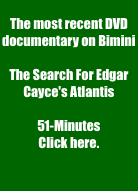 | ||||
 | ||||
Report on January/February 2009 Bimini & Andros Expedition The ARE's Search For Atlantis Project Expands Scope Bermuda Triangle Mystery Also Explored—More Planes Found by Dr. Greg Little [Note: The "Atlantis' Expeditions" are part of the A.R.E.'s Search for Atlantis Project. The A.R.E. is the official Edgar Cayce Organization, a nonprofit that publishes a magazine and monthly newsletters that keep members up-to-date on all research. The A.R.E. has made a special offer to Coast-to-Coast AM listeners with substantial book and dvd discounts as well as an inexpensive 3-month trial membership. For information on this offer, click here.] From late January to February 13, 2009 Dr. Lora Little and I were involved in a long and often unexpected series of events while exploring Bimini and Andros as part of the ARE's Search For Atlantis Project. Two friends and professionals, filmmaker Stan Prachniak and Kimberly Prachniak, Stan's wife who has a master's degree and works as a research board administrator at a medical school, joined the team for the first half of the expedition. So many things transpired on this extended venture that I simply can't relate them all. Both Stan and Kimberly Prachniak wrote summaries of their experiences. These reports will give people who are interested a good idea of what these trips are really like. Stan's report is here. Kim's report is here. This trip began the use of our own boat, a 26-foot nameless catamaran powered by a 250 hp, 4-stroke engine that can reach speeds of 55 mph. Unfortunately the top speed can only be reached in ideal conditions, meaning a glass-like surface. Most of the trip we went between 8 mph to 45 mph—a speed seldom reached and only in enclosed, protected harbor-like areas. The boat also has a secondary motor for emergencies, which we used, carries enough fuel for a 300 mile trip (which we used)and fresh water (also used), powerful radios, a satellite phone, side-scan sonar, gps navigation, 2 underwater video systems, and so much more equipment and safety gear that I won't mention it all. It has a draft one one foot. Thankfully, both Krista and Eslie Brown were along at various times. One interesting and harrowing adventure was when Stan Prachniak and I (with no one else on board) motored the boat 50-miles down the Tongue of the Ocean from Morgan's Bluff at Andros into the main harbor at AUTEC, near Fresh Creek. We did this at night and in bad weather with heavy winds and huge waves. Moving through multiple reefs at night is scary, but we did it without problems. There were a lot of interesting ships moored at AUTEC and we were immediately and sternly ordered out. Three hours earlier we entered Morgan's Bluff through reef after reef that were ominously just below the surface and concealed by whitecap waves driven by high winds.We were pounded by heavy rain that hit so hard we could barely see. In truth, the entire trip was done in high winds, choppy seas and huge, rolling waves. On the initial part of the trip, over a five-day period, we were accompanied by film production team filming two documentaries for a new series on The History Channel. The series is called "History Quest" and will premiere in June 2009. The first show is on the Bermuda Triangle. The fourth show in the series is on Atlantis. We took the film crew to several underwater planes and also to several crashed planes on land at Andros. We also took them to several areas where we are certain that remnants of an ancient maritime culture could be found. At the Bimini Road we found some of the most impressive evidence that anyone has ever "uncovered" there. All of the skeptics' claims about the Bimini Road are false except one. They have related that the Bimini Road is constructed of beachrock, and it is. Of course, the original discoverer of the structure, Dr. J. Manson Valentine related that it was made from cut beachrock, but the skeptics ignore that fact and act as if they were the first and only ones to say it. As a sidenote, virtually all of the ancient Mediterranean harbors were made from cut beachrock. However, the main skeptic has now asserted that all of the ancient Mediterranean harbors might well be natural beachrock formations! The Bimini Road is an ancient harbor, at least in its most "recent" use, if 3000 BC can be called recent. There are many multiple layers at the formation, with huge cubic stones underlying some of the larger stones that are seen from the surface. Under almost every large block, if one takes the time to actually look, there are wedge stones and cut rectangular blocks that were used for leveling. And toolmarks are apparent on many of these. It takes hard work and time to discover these, something the skeptics failed to do. The Bimini Road controversy, and the involvement of both archaeologists and geologists in what is clearly scientific misconduct, is one of the saddest incidents in modern scientific history. After the Histrory Channel crew and the Prachniaks flew out of Andros to return to the states, an unexpected problem required that we spend a night on the boat in the ocean. The next day we towed the boat to Nassau (at 8 mph) to have an engine repaired. Lora and I flew back to the states but returned to Bimini only a day later where Eslie Brown had moved the boat after the motor was repaired. We then spent several days exploring other spots on the Great Bahama Bank that we had previously discovered in a 2008 aerial survey. We investigated about 25 spots finding at least 3 more crashed planes, lots of dumped things (3 cars/trucks), an odd missile or bomb-like object, and curious formations. I speculate that Flight 19 may actually be in this area rather than in the areas much further to the north where virtually all other researchers think it went down. However, the Bermuda Triangle aspect of the search is actually a secondary goal. Our main goal in this search is to find remnants of building structures that are obvious and definitive. During the last Ice Age, and in the time period from about 3000 BC and earlier, the Great Bahama Bank was above the sea level, consisting of a fairly flat plain extending for several hundred miles in each direction. On the final day of the search we were looking at spots located about 70-miles SSW from Bimini. The weather was windy and the seas choppy. At the end of day, only 15 minutes before we had to make the journey back to Bimini, we found what looks like a building structure on the bottom in about 20-feet of water. There were large stone blocks laying on the top of a more massive formation of sand and grass. Between some of the blocks were the remains of wooden beams that look unlike the remains of wooden ships we have earlier found. The wood appears to have been preserved by usually being covered by sand and the stone itself. But the actual purpose of the stone and wood is unclear. In March, after the Palestine, Texas Atlantis Conference, we are returning to the area to continue the search. On this trip we have agreed to spend a few days with another film crew with The History Channel working for a different series. Other trips are planned for April, May, and June. There are over 100 other spots (identified in the 2008 aerial search) that we did not investigate on this trip. In addition, we will begin by taking a more careful and extended look at the spot which might be building ruins. At the Palestine Atlantis Conference we will show underwater video of the planes and other formations we found during this trip. | ||